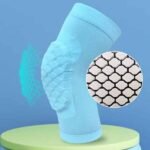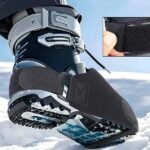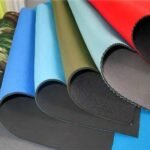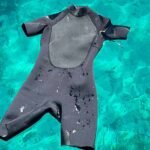It happens to almost everyone: you pull on your wetsuit and it feels tighter than last summer, or your new neoprene tote seems stiffer than expected right out of the box. Whether it’s a dive suit, laptop sleeve, or drink koozie, neoprene doesn’t always start with the perfect fit. The good news? You can safely stretch neoprene fabric — if you understand how it behaves.
Neoprene can be stretched by applying controlled heat and gentle tension. The safest methods include warm-water soaking, low-heat drying, or steaming to relax the foam cells, allowing it to regain elasticity. Avoid direct ironing or overheating, which can damage the rubber structure or delaminate the fabric layers.
Neoprene isn’t like cotton — it’s a closed-cell synthetic rubber that expands slightly with warmth and movement. When you apply the right amount of heat and pressure, its structure “remembers” how to relax. The challenge is knowing how far to go before risking damage. This guide walks you through the science, techniques, and insider tips that manufacturers use to control neoprene elasticity — so you can make tight suits fit, reshape accessories, and avoid common mistakes.
Let’s dive into the details.
What Is Neoprene Fabric and Why Does It Need Stretching?

Neoprene is a synthetic rubber foam (polychloroprene) laminated with fabric. It may need stretching to improve fit, comfort, or flexibility in products like wetsuits, bags, and covers. When neoprene is cold, compressed, or stored folded, it becomes less pliable. Gentle heat and movement help re-expand its foam cells, restoring softness and stretch.
Understanding Neoprene’s Structure
Neoprene isn’t a fabric in the traditional sense — it’s a closed-cell rubber foam made by polymerizing chloroprene. Each microscopic cell holds gas, acting like tiny bubbles inside the sheet. These air pockets make neoprene buoyant, flexible, and insulating, which is why it’s used in wetsuits, laptop sleeves, medical braces, and protective gear.
But those same air cells can become “locked” when the material is folded or compressed. For example, a new neoprene sleeve shipped in vacuum packaging might feel stiff because its foam structure is slightly flattened. Similarly, a wetsuit stored in a cold garage loses flexibility as the rubber hardens.
Stretching neoprene, therefore, is not about forcing it longer — it’s about relaxing it back to its natural, expanded state.
Common Scenarios Where Stretching Helps
- New wetsuits: Break-in period before natural body heat softens material.
- Bags or sleeves: Molded parts that need reshaping to fit contents.
- Craft projects: DIY users need to ease neoprene for wrapping or gluing curves.
- Sportswear: Adjusting elasticity for better mobility in compression gear.
| Situation | Cause of Tightness | Safe Stretch Solution |
|---|---|---|
| Wetsuit feels small | Cold or compressed storage | Warm-water soak + wear |
| Bag warped from packaging | Foam cell compression | Steam and reshape |
| DIY craft too stiff | Thick or laminated neoprene | Warm towel press |
| Neoprene cover shrank | Heat exposure then cooled | Controlled rewarming |
Why Stretching Matters
- Enhances comfort and fit.
- Restores softness and shape.
- Prevents tearing at stress points.
- Extends product lifespan.
When done right, stretching neoprene is both safe and effective — but choosing the right technique depends on the type of neoprene you’re dealing with.
Which Types of Neoprene Are the Most Stretchable?

Chloroprene Rubber (CR) neoprene is the most elastic and durable, offering up to 30–40% stretch. Styrene-Butadiene Rubber (SBR) neoprene is cheaper and less flexible (10–20%). Stretch also depends on fabric backing: Lycra or jersey-backed neoprene moves better than nylon or polyester-laminated types.
Comparing Neoprene Types
Not all neoprene behaves the same. Manufacturers blend or laminate neoprene to achieve different characteristics. Knowing what kind of neoprene you have determines how much it can stretch safely.
1. CR vs SBR Neoprene
- CR (Chloroprene Rubber) – high elasticity, used in premium wetsuits and performance wear. Retains shape even after repeated stretching.
- SBR (Styrene-Butadiene Rubber) – more economical, used for bags, sleeves, and koozies. Slightly stiffer, less recovery.
- Blend Neoprene – combines CR and SBR for balanced cost and flexibility.
| Type | Elasticity | Durability | Cost | Common Use |
|---|---|---|---|---|
| CR | 30–40% | Excellent | $$$ | Wetsuits, sports gear |
| SBR | 10–20% | Good | $ | Bags, koozies, crafts |
| CR/SBR Mix | 20–30% | Very Good | $$ | Accessories, covers |
2. Fabric Backing and Stretch Direction
Most neoprene is laminated with fabric on one or both sides. This backing controls direction and degree of stretch:
- Lycra or spandex knit – 4-way stretch, soft and flexible.
- Polyester jersey – 2-way stretch, common in bags and sleeves.
- Nylon tricot – tough and abrasion-resistant, less elastic.
3. Thickness vs Flexibility
Thickness directly affects elasticity: thinner neoprene stretches more easily.
| Thickness | Stretch Range | Applications |
|---|---|---|
| 1–2 mm | High | Koozies, sleeves |
| 3–4 mm | Moderate | Bags, braces |
| 5+ mm | Low | Wetsuits, protective gear |
In short: the thinner, softer, and higher-grade your neoprene is, the easier it will respond to controlled stretching.
How Do You Safely Stretch Neoprene Without Damaging It?
To safely stretch neoprene, use mild heat and moisture — soak it in lukewarm water, steam gently, or use a low-heat hair-dryer while applying gradual tension. Keep temperatures under 45 °C (113 °F) to avoid melting the foam or weakening the adhesive between layers.
Step-by-Step Safe Stretching Methods
Stretching neoprene is part art, part science. The key principle: relax the foam, don’t force it. Here’s how to do it safely.
1. The Warm-Water Soak (Ideal for Wetsuits & Thick Fabric)
- Fill a basin with lukewarm water (30–35 °C).
- Submerge the neoprene item for 10–15 minutes.
- Remove and gently stretch by hand or wear it (for wetsuits).
- Let it cool while maintaining shape.
This method lets heat penetrate evenly, expanding the foam’s micro-cells naturally. Divers often use this to “pre-fit” a new wetsuit before first dive.
2. The Steam Relaxation Method (For Bags, Sleeves & Accessories)
- Hang the item on a wide hanger.
- Use a hand steamer or the steam from a hot shower for 5–10 minutes.
- Massage and reshape the neoprene with your hands.
- Lay flat to air dry.
Steam adds moisture and heat evenly, softening foam without scorching.
3. The Hair-Dryer Technique (For Targeted Areas)
- Use low or medium heat only.
- Keep the nozzle at least 30 cm (12 in) away.
- Move continuously while gently stretching.
- Avoid over-focusing on seams.
This method is useful for small adjustments — for example, expanding a tight sleeve opening or reshaping a bag corner.
4. The Warm-Towel Press (For DIY Craft Sheets)
- Place a damp towel over the neoprene sheet.
- Run a warm (not hot) iron across the towel for 30 seconds.
- Gently stretch the material beneath.
This indirect heat relaxes surface tension without direct rubber contact.
| Method | Best For | Max Temp | Duration | Notes |
|---|---|---|---|---|
| Warm-Water Soak | Wetsuits, thick covers | 35 °C | 15 min | Uniform softening |
| Steam | Bags, sleeves | 40 °C | 10 min | Shape recovery |
| Hair-Dryer | Small areas | 40–45 °C | 3–5 min | Keep moving |
| Warm-Towel | Flat sheets | 35 °C | 2 min | Protect surface |
What Tools and Techniques Help in Stretching Neoprene Effectively?

Use steamers, warm towels, or hair-dryers to apply mild heat; shaping molds, gloves, or clamps help maintain even tension. Always stretch gradually, following the grain of the backing fabric to prevent tearing or delamination.
Professional and Household Tools
Essential Tools
- Steamer or Shower Room: For uniform warmth without direct heat.
- Hair-Dryer: Adjustable control for localized softening.
- Stretching Frame or Mold: Keeps material in position during cooling.
- Protective Gloves: Prevents fingerprints or dents while hot.
- Soft Towels or Cloths: For pressing or reshaping after heating.
Manufacturers like Szoneier use industrial steam chambers and tensioning frames to “pre-relax” neoprene rolls before cutting, ensuring consistency in finished bags or wetsuits. Home users can simulate similar results on a smaller scale.
Stretch Direction Matters
Neoprene stretches more across the grain than along it. When stretching a laminated piece, pull evenly in both directions to avoid fabric distortion.
Controlling Tension
Never yank neoprene. Instead, apply gradual pressure for several seconds, release, then repeat. The foam cells respond better to rhythmic movement than constant force.
| Technique | Purpose | Tool |
|---|---|---|
| Uniform softening | Steam / warm water | Steamer or tub |
| Precision stretch | Targeted reshaping | Hair-dryer |
| Maintaining shape | Molding support | Frame or towels |
| Safety handling | Avoid burns | Gloves |
Pro Tip: “Heat, Stretch, Cool” Cycle
After stretching, let neoprene cool in shape — this “locks in” the new elasticity. If you move or fold it immediately, wrinkles can reform.
Do Different Applications Require Different Stretching Methods?

Yes — wetsuits, bags, and accessories each respond differently. Wetsuits need even body-heat softening, while bags and sleeves can be steamed or reshaped. Thicker products require more time and lower heat, whereas thin neoprene responds faster but risks warping if overheated.
Application-Specific Approaches
1. Wetsuits & Diving Gear
- Soak in lukewarm water before wearing for the first time.
- Move naturally for 10–15 minutes — body heat completes the stretch.
- Avoid sharp pulls near seams or zippers.
- Hang flat to cool in shape.
Professional divers often “condition” their suits using this method before dives to ensure flexibility and comfort.
2. Neoprene Bags & Laptop Sleeves
- Use a hair-dryer or steam for 3–5 minutes.
- Stuff the bag with towels to hold its 3D shape.
- Smooth corners and panel creases by hand while warm.
- Allow to rest overnight before use.
Szoneier’s internal lab tests show that 3 mm neoprene bags recover up to 98% of shape after controlled steam reshaping — compared to only 85% when left cold.
3. Drink Koozies & Accessories
Thin neoprene (2 mm) reacts quickly to heat. Simply fitting it over a warm bottle or can for a few minutes will restore its elasticity.
4. Upholstery or Automotive Uses
These applications require uniform stretching over frames or molds. Warm the sheet gently, then attach while pliable. Avoid re-heating in place once glued, as adhesives may soften.
| Application | Method | Heat Level | Duration | Notes |
|---|---|---|---|---|
| Wetsuits | Warm-water + body heat | 35 °C | 15 min | Wear while drying |
| Bags/Sleeves | Steam | 40 °C | 10 min | Reshape & stuff |
| Koozies | Mild warmth | 30 °C | 3 min | Quick recovery |
| Upholstery | Heat & mold | 40 °C | Variable | Even tension |
Different products require different approaches — but the core rule remains: gentle, consistent heat and movement always outperform force.
Is It Possible to Permanently Stretch Neoprene?

Neoprene can permanently stretch up to 5–10% before losing elasticity. Beyond that, its foam cells rupture or delaminate, causing irreversible deformation. Safe “semi-permanent” reshaping is possible through repeated warm-stretch-cool cycles under low tension.
The Limits of Elastic Memory
Neoprene’s structure gives it elastic memory — it returns to shape when cooled. However, after repeated heating or prolonged tension, the cells slightly deform, leading to permanent stretch.
Safe Permanent Stretch Range
| Neoprene Grade | Safe Stretch Limit | Recovery Rate |
|---|---|---|
| CR Premium | 10% | 90–95% |
| SBR Standard | 5–8% | 80–90% |
| CR/SBR Blend | 8–10% | 85–92% |
Key Insight:
- Permanent stretching is gradual. It happens through cycles of use, warmth, and rest — not one single pull.
- Attempting to double size in one go will tear seams or foam cells.
- In manufacturing, Szoneier pre-tests elasticity to ensure products retain performance after repeated bending and heat exposure.
If your neoprene item feels tight beyond comfort, resizing or custom-manufactured replacement panels may be a smarter solution than over-stretching.
Are There Common Mistakes When Trying to Stretch Neoprene?
Common mistakes include using excessive heat, direct ironing, uneven pulling, or stretching laminated neoprene while dry. These can cause delamination, permanent indentations, or melting. Always apply mild heat, moisture, and gradual tension for safe results.
1. Direct Heat Exposure
Irons, tumble dryers, or hot blowers can exceed 60 °C — high enough to melt neoprene’s surface. Always use indirect warmth (steam, water, or towel barrier).
2. Over-Pulling
Pulling with sudden force tears foam cells and weakens seams. For thick neoprene, heat first, stretch slowly, then hold.
3. Ignoring Fabric Grain
Every laminated neoprene has a stretch direction. Pulling diagonally creates uneven tension, wrinkles, or misalignment in stitched items.
4. Stretching When Cold
Cold neoprene stiffens like rubber. Always warm it to at least room temperature before manipulation.
5. Using Chemical Softeners
Household detergents or oils can degrade neoprene’s rubber and adhesive. Stick to plain water or mild wetsuit shampoo.
6. Skipping the Cooling Phase
After stretching, neoprene must rest and cool in its new shape. Skipping this step allows memory rebound, undoing your work.
| Mistake | Consequence | Prevention |
|---|---|---|
| Ironing directly | Melts fabric | Use towel barrier |
| Stretching dry | Cracking | Warm/steam first |
| Fast pull | Tearing | Gradual pressure |
| Chemical exposure | Adhesive failure | Use water only |
| No cooling | Rebound | Let rest in shape |
Conclusion — Stretch Smart, Maintain Quality, and Choose Better Neoprene
By now, you’ve learned that stretching neoprene is more science than muscle work. The secret lies in low heat, gradual tension, and patience. From wetsuits to laptop sleeves, the right method restores softness and comfort without damage.
But remember: the best neoprene starts with quality manufacturing. At Szoneier, we don’t just make neoprene products — we engineer performance. With over 18 years of R&D and production experience, Szoneier manufactures everything from neoprene bags and koozies to wetsuits and custom covers.
Our materials are:
Heat-tested for optimal elasticity
Backed with high-stretch jerseys or Lycra
Fully customizable (logo, color, thickness, lamination)
Produced with low MOQs and free design assistance
If you need OEM, private label, or custom neoprene solutions — whether it’s a soft, flexible bag or a precision-fitted wetsuit — we’ll help you get it right from the start.
Contact Szoneier today for samples or a free design consultation.
Stretch your ideas — not your materials — with a factory that understands how neoprene truly works.











